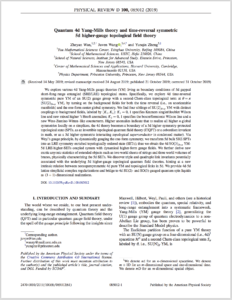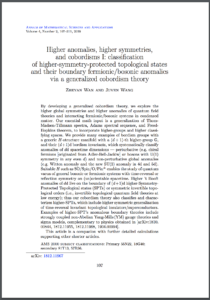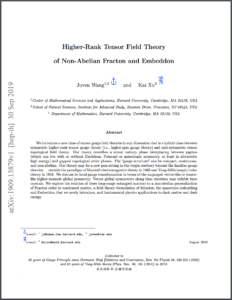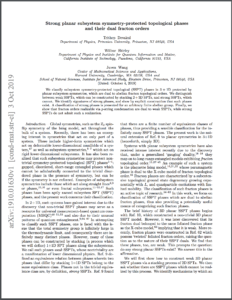PHYS. REV. D 100, 085012 – PUBLISHED 21 OCTOBER 2019

Title: Quantum 4d Yang-Mills theory and time-reversal symmetric 5d higher-gauge topological field theory
Zheyan Wan, Juven Wang , and Yunqin Zheng
Abstract: We explore various 4d Yang-Mills gauge theories (YM) living as boundary conditions of 5d gapped short-/long-range entangled (SRE/LRE) topological states. Specifically, we explore 4d time-reversal symmetric pure YM of an SU(2) gauge group with a second-Chern-class topological term at θ=Ï€ [SU(2)θ=Ï€ YM], by turning on the background fields for both the time reversal (i.e., on unorientable manifolds) and the one-form center global symmetry. We find four siblings of SU(2)θ=Ï€ YM with distinct couplings to background fields, labeled by (K1,K2): K1=0, 1 specifies Kramers singlet/doublet Wilson line and new mixed higher ‘t Hooft anomalies; K2=0, 1 specifies the boson/fermionic Wilson line and a new Wess-Zumino-Witten-like counterterm. Higher anomalies indicate that to realize all higher n-global symmetries locally on n simplices, the 4d theory becomes a boundary of a 5d higher-symmetry-protected topological state (SPTs, as an invertible topological quantum field theory (iTQFT) or a cobordism invariant in math, or as a 5d higher-symmetric interacting topological superconductor in condensed matter)… Via Weyl’s gauge principle, by dynamically gauging the one-form symmetry, we transform 5d bulk SRE SPTs into an LRE symmetry-enriched topologically ordered state (SETs); thus we obtain the 4d SO(3)θ=Ï€ YM-5d LRE-higher-SETs coupled system with dynamical higher-form gauge fields. We further derive new exotic anyonic statistics of extended objects such as two world sheets of strings and three world volumes of branes, physically characterizing the 5d SETs. We discover triple and quadruple link invariants potentially associated with the underlying 5d higher-gauge topological quantum field theories, hinting at a new intrinsic relation between nonsupersymmetric 4d pure YM and topological links in 5d. We provide 4d-5d lattice simplicial complex regularizations and bridge to 4d SU(2)- and SO(3)-gauged quantum spin liquids as (3+1)-dimensional realizations.
Journal: PhysRevD
PDF: PhysRevD.100.085012
Annals of Mathematical Sciences and Applications| Volume 4 (2019): Number 2

Title: Higher Anomalies, Higher Symmetries, and Cobordisms I: Classification of Higher-Symmetry-Protected Topological States and Their Boundary Fermionic/Bosonic Anomalies via a Generalized Cobordism Theory
Zheyan Wan & Juven Wang
Abstract: By developing a generalized cobordism theory, we explore the higher global symmetries and higher anomalies of quantum field theories and interacting fermionic/bosonic systems in condensed matter. Our essential math input is a generalization of Thom-Madsen-Tillmann spectra, Adams spectral sequence, and Freed-Hopkins theorem, to incorporate higher-groups and higher classifying spaces. We provide many examples of bordism groups with a generic HH-structure manifold with a (d+1)-th(d+1)-th higher-group ð”¾G, and their (d+1)d(d+1)d bordism invariants, which systematically classify anomalies of dddd spacetime dimensions – perturbative (e.g. chiral fermions [originated from Adler-Bell-Jackiw] or bosons with U(1)U(1) symmetry in any even d) and non-perturbative global anomalies (e.g. Witten anomaly and the new SU(2)SU(2) anomaly in 4d4d and 5d5d). Suitable HH such as SO/Spin/O/Pin±SO/Spin/O/Pin± enables the study of quantum vacua of general bosonic or fermionic systems with time-reversal or reflection symmetry on (un)orientable spacetime. Higher ‘t Hooft anomalies of dddd live on the boundary of (d+1)d(d+1)d higher-Symmetry- Protected Topological states (SPTs) or symmetric invertible topological orders (i.e., invertible topological quantum field theories at low energy); thus our cobordism theory also classifies and characterizes higher-SPTs, which include higher symmetric generalization of time-reversal invariant topological insulators/superconductors. Examples of higher-SPT’s anomalous boundary theories include strongly coupled non-Abelian Yang-Mills (YM) gauge theories and sigma models, complementary to physics obtained in [arXiv:1810.00844, 1812.11955, 1812.11968, 1904.00994].
This article is a companion with further detailed calculations supporting other shorter articles.
Journal: AMSA

Title: Higher-Rank Tensor Field Theory of Non-Abelian Fracton and Embeddon
Abstract: We introduce a new class of tensor gauge field theories in any dimension that is a hybrid class between symmetric higher-rank tensor gauge theory (i.e., higher-spin gauge theory) and anti-symmetric tensor topological field theory. Our theory describes a mixed unitary phase interplaying between gapless (which can live with or without Euclidean, Poincaré or anisotropic symmetry, at least in ultraviolet high energy) and gapped topological order phases. The “gauge structure” can be compact, continuous, and non-abelian. Our theory may be a new gem sitting in the virgin territory beyond the familiar gauge theories – outside the paradigm of Maxwell electromagnetic theory in 1865 and Yang-Mills isospin/color theory in 1954. We discuss its local gauge transformation in terms of the ungauged vector-like or tensor-like higher-moment global symmetry. Vector global symmetries along time direction may exhibit time crystals. We explore the relation of these long-range entangled matters to a non-abelian generalization of Fracton order in condensed matter, a field theory formulation of foliation, the spacetime embedding and Embeddon that we newly introduce, and fundamental physics applications to dark matter and dark energy.
ArXiv: 1909.13879
PDF: 1909.13879

Title: Strong planar subsystem symmetry-protected topological phases and their dual fracton orders
Trithep Devakul, Wilbur Shirley, Juven Wang
Abstract: We classify subsystem symmetry-protected topological (SSPT) phases in 3+1D protected by planar subsystem symmetries, which are dual to abelian fracton topological orders. We distinguish between weak SSPTs, which can be constructed by stacking 2+1D SPTs, and strong SSPTs, which cannot. We identify signatures of strong phases, and show by explicit construction that such phases exist. A classification of strong phases is presented for an arbitrary finite abelian group. Finally, we show that fracton orders realizable via p-string condensation are dual to weak SSPTs, while strong SSPTs do not admit such a realization.
ArXiv: 1910.01630
PDF: 1910.01630

Title: Higher-Rank Non-Abelian Tensor Field Theory: Higher-Moment or Subdimensional Polynomial Global Symmetry, Algebraic Variety, Noether’s Theorem, and Gauge
Juven Wang, Kai Xu, Shing-Tung Yau
Abstract: With a view toward a theory of fracton and embeddon in condensed matter, we introduce a higher-moment polynomial degree-(m-1) global symmetry, acting on complex scalar/vector/tensor fields. We relate this higher-moment global symmetry of n-dimensional space, to a lower degree (either ordinary or higher-moment, e.g., degree-(m-1-â„“)) subdimensional or subsystem global symmetry on layers of (n−ℓ)-submanifolds. These submanifolds are algebraic affine varieties (i.e., solutions of polynomials). The structure of layers of submanifolds as subvarieties can be studied via mathematical tools of embedding, foliation and algebraic geometry. We also generalize Noether’s theorem for this higher-moment polynomial global symmetry. We can promote the higher-moment global symmetry to a local symmetry, and derive a new family of higher-rank-m symmetric tensor gauge theory by gauging. By further gauging a discrete charge conjugation symmetry, we derive a new more general class of non-abelian rank-m tensor gauge field theory: a hybrid class of (symmetric or non-symmetric) higher-rank-m tensor gauge theory and anti-symmetric tensor topological field theory, generalizing [arXiv:1909.13879]’s theory interplaying between gapless and gapped sectors.
ArXiv: 1911.01804
PDF: 1911.01804

Title: Beyond Standard Models and Grand Unifications: Anomalies, Topological Terms and Dynamical Constraints via Cobordisms
Abstract: We classify and characterize fully all invertible anomalies and all allowed topological terms related to various Standard Models (SM), Grand Unified Theories (GUT), and Beyond Standard Model (BSM) physics. By all anomalies, we mean the inclusion of (1) perturbative/local anomalies captured by Feynman diagram loop calculations, classified by ℤ free classes, and (2) non-perturbative/global anomalies, classified by finite group ℤN torsion classes. Our theory built from [arXiv:1812.11967] fuses the math tools of Adams spectral sequence, Thom-Madsen-Tillmann spectra, and Freed-Hopkins theorem. For example, we compute bordism groups ΩHd and their invertible topological field theory invariants, which characterize dd topological terms and (d−1)d anomalies, protected by the following symmetry group H: Spin×SU(3)×SU(2)×U(1)Γq for SM with Γq:=ℤq as q=1,2,3,6; Spin×Spin(n)ℤF2 or Spin×SO(n) for SO(10) or SO(18) GUT as n=10,18; Spin×SU(n) for Georgi-Glashow SU(5) GUT as n=5; (Spin×SU(4)×(SU(2)×SU(2))Γq)/ℤF2 for Pati-Salam GUT as q=1,2; etc. Our approach offers an alternative view of all anomaly matching constraints built from the lower-energy (B)SM or GUT, in contrast to high-energy Quantum Gravity or String Theory Swampland program, as bottom-up/top-down complements. Symmetries and anomalies provide constraints of kinematics, we further comment on constraints of quantum gauge dynamics, and new predictions of possible extended defects/excitations plus hidden BSM non-perturbative topological sectors.
ArXiv: 1910.14668
PDF: 1910.14668
Title: Gauge Enhanced Quantum Criticality and Time Reversal Domain Wall: SU(2) Yang-Mills Dynamics with Topological Terms
Juven Wang, Yi-Zhuang You, Yunqin Zheng
Abstract: We study the low energy dynamics of the four siblings of Lorentz symmetry enriched SU(2) Yang-Mills theory with a theta term at θ=π. Since there exists a mixed anomaly between time reversal symmetry and the center symmetry, the low energy dynamics must be nontrivial. We focus on two possible scenarios: 1) time reversal symmetry is spontaneously broken by the two confining vacua, and 2) the low energy theory describes a U(1) spin liquid which is deconfined and gapless while preserving time reversal symmetry. In the first scenario, we first identify the global symmetry on the time reversal domain wall, where time reversal symmetry in the bulk induces a ℤ2 unitary symmetry on the domain wall. We explore how the Lorentz symmetry and the unitary ℤ2 symmetry enriches the domain wall theory. In the second scenario, we relate the symmetry enrichments of the SU(2) Yang-Mills to that of the U(1) spin liquids. This further opens up the possibility that SU(2) QCD with large and odd flavors of fermions could be a direct second order phase transition between two phases of U(1) spin liquids as well as between a U(1) spin liquid and the a trivial paramagnet, where the gauge symmetry is enhanced to be non-Abelian at and only at the transition. We characterize these transitions, and name them as \emph{Gauge Enhanced Quantum Critical Points}.
ArXiv: 1910.14664
PDF: 1910.14664.pdf

